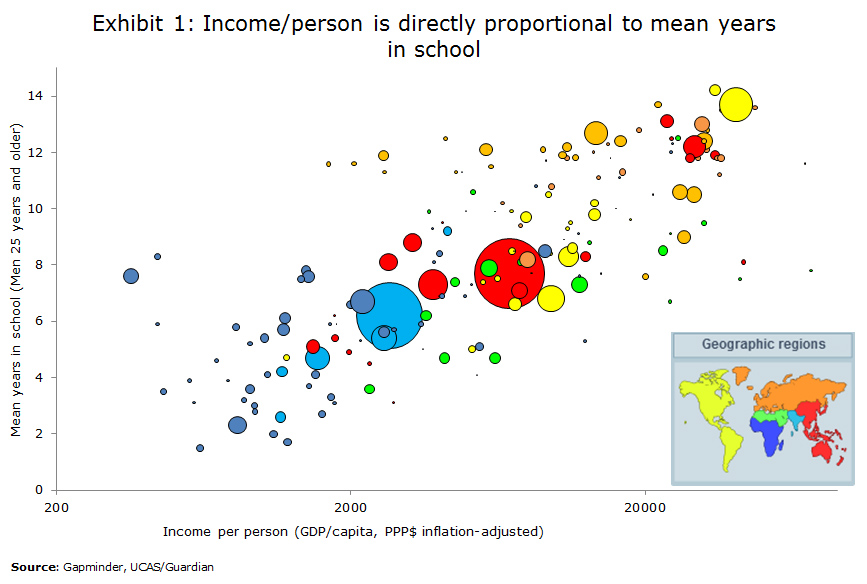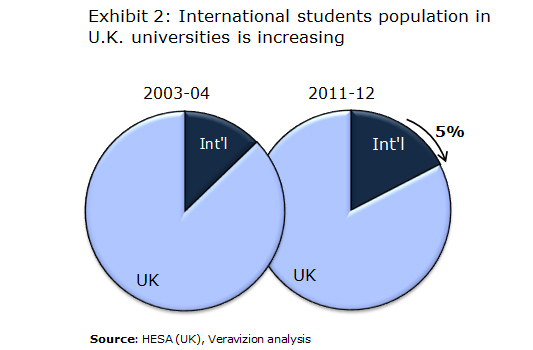U p until the nineteenth century, higher education used to be pursued primarily by those from elite background. So demographically speaking, young men predominantly from affluent well-connected families largely formed the pool of such students. Many factors have caused this demographic profile to shift from privileged few to general mass. It is anticipated that by 2020, almost 50% of students studying in the U.S. and U.K. universities will be from diverse cultures, backgrounds, age-groups, and nationalities.
Latest UN data indicates that there is a direct correlation between mean-years-in-school and income-per-person (GDP per capita). As shown in exhibit 1, people from developed countries having better avenues at taking up higher education are generally better-off financially. They appear on the upper-right end of the chart. On the other hand, people from poorer countries with lower education levels languish at the bottom-left of the chart. There seems to be a widespread perception that higher levels of knowledge and skills open doors to higher-paying jobs and thus result in better quality of life.

The outcome is that people from diverse cultures worldwide are pursuing higher education in the courses relevant across the world today. There is an increasing trend to study in prestigious universities in the developed countries, especially in the U.S. and the U.K, for higher education.
Let us briefly analyze how the higher education landscape is panning out in terms of nationality, age, and gender diversity.
Compared to a decade ago, 30% more international students were studying at U.S. colleges and universities, and 5% more international students were studying at U.K. universities in 2011-12 (see exhibit 2 for the trend in U.K. universities). The most noticeable increases in international students are from Asia, the Middle East, and other emerging economies. This trend of greater participation of ethnically diverse population points toward globalization in the education sector.

There is one other interesting trend that has been noticed recently. Universities in the U.S. are witnessing an increase in the older (typically aged 25-34) students than in the past. In today’s information age, innovation is happening fast and things are becoming obsolete faster. People are feeling the need to learn new technology, new business models, and new skills, to stay tuned with the changing times. This perceived need to keep the knowledge current and to remain relevant in the job market is prompting students from various backgrounds to return to school. These are the older students, a.k.a. students of non-traditional age-group, that could not continue their education earlier due to various reasons such as low income, lack of suitable avenues, family obligations, and other socio-economic reasons. With the advent of internet and online education options especially in the U.S., there are an increasing number of older, even married, students with more varying demographics joining higher education, thereby skewing the overall demographic profile of students. By contrast, universities in the U.K. are experiencing an increase in the number of younger students and decrease in those aged over 30. This may be explained by the fact that online channel as an effective medium of learning is yet to get widespread acceptance in the U.K. Most of the well-known providers of online education today, for example, Coursera, Udacity, and edX, are based in the U.S. Online medium of education is typically preferred by older students having jobs and families.
Finally, gender diversity is playing a big role in the changing trends. Female students are fast occupying the seats in classrooms that once were occupied by their male counterparts. In the latest report published by HESA (UK), more than 50% of students studying in U.K. universities in 2011-12 were female. The trend is not much different in the U.S. universities either. There were interesting trends within region-wide distributions too, such as lower female students population from countries considered conservative. However, in general, there is an evidence of definite increase in participation of female students in higher education.
But why are student demographics important to universities?
Students are the main stakeholders in the success of an educational institution. Students’ curricular and extracurricular activities, interests, and opinions are driven by their beliefs, faiths, likes, and dislikes which in turn are based on their cultures and ethnicity. Thus, their demographic profile directly affects the way their experiences will shape-up in any educational institution. The universities can no longer assume that students from diverse communities will participate in courses and activities traditionally offered by them. This calls for detailed analysis and deep reflection on part of university leaders to design and offer an ideal educational experience for this shifting student demography.
How leaders are acting in response to the changing demographic trend?
The student population will become more ethnically diverse in the years to come. Educational institutions are now getting accustomed to the rapidly changing student demographics in the sector. Leaders from the top universities are making the most of this opportunity by putting in place such mechanisms that will ensure responsiveness to the needs of these new learners. The development of this yet untapped student demography means new avenues of revenues for the universities already grappling with funding issues. One of the first steps the leaders are taking is to institutionalize analytics at individual student and course level. This will help them in the following three ways: First, student-level-analytics includes a well-defined feedback seeking mechanism from students that let the leaders feel running pulse of the students’ preferences, likes-dislikes, and attitudes. Second, course-level-analytics gives inputs on performance of teaching faculties on all courses, research activities, and course-effectiveness index, and checks the courses’ continued relevance. The combination of these two analytics can be very effective in keeping a tab on ‘drop-out-risk’ of students. Last and most important, the leaders now have hard-data to take quick information-driven decisions with less gut-feeling and less uncertainty. Better still, they are able to be accountable with more confidence and can utilize the information to win over their sponsors and stakeholders. They are able to apply it in a day-to-day decision making so that the educational institutions become ready to embrace the future with welcoming arms.
Related Posts:
- MOOC and the education system continuum
- Data Science: The next frontier for business competitiveness
- Fields Medal, Open Problem, and Business Decisions
<– Universities: Funding and ROI challenges
Shifting focus of universities –>
Do follow Veravizion on LinkedIn, Twitter, Facebook, or Google+ to receive easy updates.